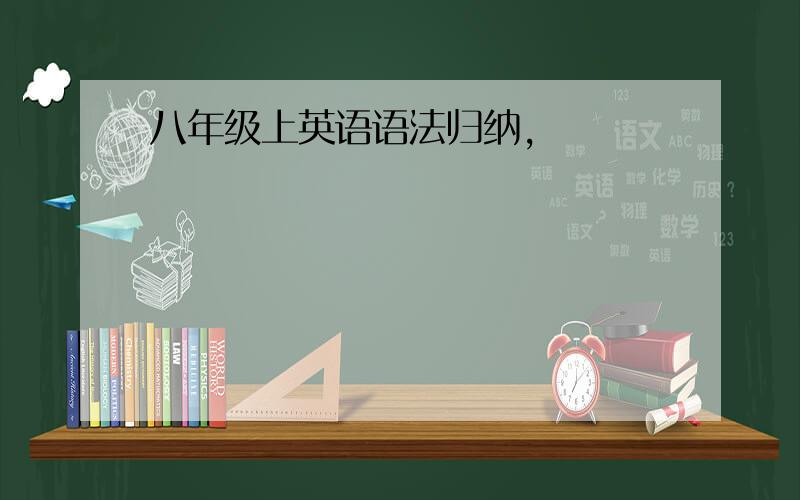八年级上英语语法归纳,
来源:学生作业帮助网 编辑:作业帮 时间:2024/04/27 19:21:49

八年级上英语语法归纳,
八年级上英语语法归纳,
八年级上英语语法归纳,
语法专项I
I. 名词:在我们身边存在着形形色色的人和事物,它们都有自己的称呼,我们用来称呼它们的词就是名词,概括来说表示人、事物、地方、现象等的名称的词都叫名词.
一. 名词的种类:名词可以分为专有名词和普通名词,普通名词又分为个体名词和集体名词,物质名词和抽象名词.
1. 专有名词:专有名词是指人、地方、团体、机构等特有的名词,它的第一个字母必须大写,专有名词前一般不加冠词.
A. 表示人名:Li Bai,Mr Black,Doctor Zhang
B. 表示地名:China,London,Zhong Guan Cun Street.
C. 由普通名词构成的专有名词:the Spring Festival, the Palace Museum.
2. 普通名词:普通名词指一类人或东西或一个抽象的名标,它可以进一步分为个体名词、集合名词、物质名词和抽象名词四类.
A. 个体名词:表示某类人或事物中的个体:student,teacher,car.
B. 集合名词:表示若干个体组成的集合体;family,police,people.
C. 抽象名词:表示动作、状态、品质、感情等抽象的概念:music,love
D. 物质名词:表示无法分为个体的物质或实物:water,tea,air
二. 名词的数:表示可以计算数目的人或物称为可数名词,表示一个用单数,两个以上用复数,可数名词单数前面一般要用不定冠词a / an,可数名词复数是在单数名词后面加“s”或“es”.可数名词复数前不能用不定冠词a / an.
1. 单数可数名词,表示“一”的概念,要用名词的单数形式,表示名词的单数,要在名词前加冠词a或an. eg:a book, a tree, a shark an octopus,an apple,an egg
2. 复数可数名词:在梦塔英语中,如果要表示“二、三、四,……”概念时,要用名词的复数形式,名词的复数形式是在单数名词后加上词尾-s或-es构成的.
A. 名词复数的规则变化. a. 在一般情况下,词尾后加-s. books,cups,beds,boys,horses
b. 以s,x,sh,ch结尾的词,词尾加-es,读|iz| buses,boxes,dishes,watches
c. 以f或fe结尾的词,先将f或fe变成v,再加-es,读|vz| half—halves,knife—knives
d. 以o结尾的词,词尾加-es或-s. zoos,photos,radios,tomatoes,potatoes
e. 以辅音字母加y结尾的词,先将y改为i再加-es. cities,families,babies
B. 名词复数的不规则变化. man—men,tooth—teeth,child—children,sheep—sheep
C. 有些名词只有复数形式 clothes,trousers,pants,glasses
3. 不可数名词表示量的概念时,在这些词前加上数量词. eg:a cup of coffee,a piece of paper,three slices of bread
II. 不定代词,我们所学的不定代词有all,both,each,every,some,any,many,much,(a)few,(a)little,either,neither,other,another,no,none以及含有some-,any-,no-等的合成代词,这些不定代词大都可以代替名词和形容词,在句中作主语、宾语、表语和定语.
一. some,any及其合成词的用法.
1. 基本用法 some,any可与单、复数和不可数名词连用. some用于肯定句中,而不能用于疑问句中,any一般用于否定句,疑问句和条件句中. eg:I have some interesting books. There is some yogurt in the bottle. I don't have any money. Were there any sharks in the aquarium?
2. 特殊用法 在疑问句中,一般不用some,只有当问句表示一种邀请或者请求,或期待一个肯定的回答时才能用some. eg:Would you like some more tea?
二. all,both的用法 1. all代表或修饰四个以上的人或事物,或不可数的东西. eg:We all like eat potato chips. All the students in our class went to the zoo. 2. both是指“两者都……” eg:The twins both have long hair. There are many trees on both sides of the street.
三. many,much,(a lot),a few,few,a little,little.这些词都可以表示数量,并且都可以修饰名词. 1. many,a lot,a few,few修饰可数名词;much,a lot,a little,little修饰不可数名词. 2. many,much,a lot,a few,a little表示肯定的意思:few,little表示否定的意思. eg:How much relish do we need? There are a few minutes left, aren't there? There is a little time left, is there?
III. 形容词的比较等级:梦塔英语中的形容词,在表示“比较——”和“最——”这样的概念时,要用特别的形式,称为比较级和最高级. 原级 比较级 最高级 young(年轻) younger(比较年轻) youngest(最年轻)
一. 变化形式如下:
1. 规则变化 构成法 原级 比较级 最高级 一般单音节词和部分双音节词在词尾加-er〔 〕(比较级)和-est〔ist〕(最高级) 以不发音的e结尾的单音节词和少数以le结尾的双音节词只在词尾加-r(比较级)和-st(最高级) “辅音字母+y”结尾的双音节词,将词尾的y改为i,再加-er和-est 重读闭音节词,只有一个辅音字母结尾时,要双写该辅音字母,再加-er,-est 部分双音节词和多音节词,在该词前面加more和the most构成比较级和最高级 tall高的(adj.) great巨大的(adj.) fast快(adj.& adv.) near附近的(adj. & adv.) nice好的(adj.) large大的(adj.) able有能力的(adj.) late晚,晚的(adj. & adv.) easy容易的(adj.) busy忙的(adj.) early早(adj. & adv.) big大的(adj.) hot热的(adj.) thin细的,瘦的(adj.) important重要的(adj.) beautiful漂亮的(adj.) slowly慢(adv.) quickly快(adv.) teller greater faster nearer nicer larger abler later easier busier earlier bigger hotter thinner more important more beautiful more slowly more quickly the tallest the greatest (the)fastest (the)nearest the nicest the largest the ablest (the)latest the easiest the busiest (the)earliest the biggest the hottest the thinnest the most important the most beautiful (the) most slowly (the) most quickly
2. 不规则变化 原级 比较级 最高级 good好的(adj.) well健康的(adj.) 好(adv.) bad坏的(adj.) ill有病的(adj.) badly坏(adv.) many多(adj. & adv.) much多(adj. & adv.) far远(adj. & adv.) little少(adj. & adv.) old老的(adj.) late迟的,晚的(adj.) better['bet ]较好的(地) worse[w :s]更坏(地) 更差(地) more[m :]更多的,更加 farther['fa: ]较远 further['f : ]进一步 less[les]较少的(地) older[' uld ]较老的 elder['eld ]年长的 later较迟的,较近的 latter['l t ]后者 (the) best[best]最好的(地) (the) worst[w :st]最坏(地) 最糟(地) (the) most[m ust]最多的(地) (the) farthest['fa: ist]最远的(地) (the) furthest['f : ist]最深远的(地) (the) least[li:st]最少的(地) the oldest[' uldist]最老的 the eldest['eldist]最年长的 the latest(时间上)最近的 the last(顺序)最后的 比较: elder和eldest主要用于表示家庭成员之间的长幼关系,如:elder sister姐姐. older和oldest则用于表示年龄大小. They are in the same age, but Li looks much older than Ma. 他们两个在年龄上一般大,但看起来李比马老的多. 二. 形容词比较等级的用法. 形容词比较等级通常分为原形,比较级和最高级三种基本形式,具体而言,它们分别以下列形式出现在句中: (1)as +原形+ as 表示“……和……相同”. (2)比较级+ than 表示“……比……较为……”. (3)the +最高级+ of / in 表示“在……中最为……”. eg:My dog is as old as that one. The jacket is as cheap as that old one. Is he as busy as before? Mary is funnier than Jane. His brother is younger than me. Tom is the happiest of us all. Spring is the best season of the year. 三. 需要注意的一些问题. 1. 在形容词比较级前还可以用much,even,far,a lot,still,a little来修饰,表示“……的多”,“甚至……”,“仍然,还……”,“更……”,以加强语气. eg:Our city is much more beautiful than yours. Japan is a little larger than Germany.
2. 表示“大几岁”,“高……”等,句型用“表示数量的词+形容词比较级.” eg:I'm two years older than you. She is a head taller than me.
3. 表示“越来越……”,句型用“比较级+ and +比较级”. eg:China is more and more beautiful. The earth is getting warmer and warmer.
4. 表示“是最……之一”句型用“one of the +形容词最高级”. eg:Beijing is one of the busiest cities in China. One of the most important languages is English.
看书后面,都印在上面
语从句,壮语从句,定语从句。一般现在时,一般过去时,现在完成时,现在进行时,一般将来时,过去进行时,过去将来时。